
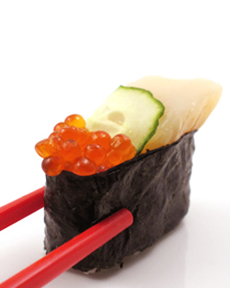 Salmon caviar is a mainstay in sushi. Photo by Jeanette Lambert | IST. Salmon caviar is a mainstay in sushi. Photo by Jeanette Lambert | IST.
May 2005
Last Updated July 2017
|
 |
Caviar Types
Page 9: Salmon Caviar, Sevruga & Other Terms With S
This is Page 9 of a ten-page glossary of caviar types. If you’d like to suggest additional words for inclusion, or think we should consider other definitions than those we have provided, use the Contact Us link on this page. You may also enjoy our many other food glossaries.
Click on a letter to go to the appropriate section.
a b c d e f g h i j k l m n o p q r s t u v w x y z
This material is copyrighted and cannot be reproduced in whole or in part
without written permission. You are welcome to link to it.
SALMON CAVIAR or ROE
North American Salmon caviar usually comes from the Chum and Silver Salmon salmon of Alaska and the Pacific Northwest, or the Chinook (King) salmon of the Great Lakes. It is bright, pearlescent, natural orange to red-orange in color; the eggs are popularly referred to as “pearls.” It is larger, juicier, and much saltier than other caviars. The eggs are a very popular garnish and are tasty as a dish in of themselves (it is a popular sushi bar item, known is ikura in Japanese). See also keta caviar. Find salmon caviar recipes.
|
|
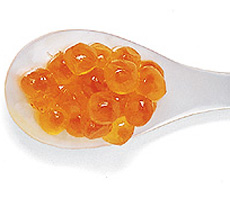
Salmon caviar. Photo courtesy CollinsCaviar.com. |
SCHIPP CAVIAR
The Schipp is a cross-breeding of Sevruga and Sterlet sturgeons. It is sometimes sold commercially as Schipp, but is usually packaged as either Sevruga or Osetra, depending on the egg size. The crossbred eggs are often less firm than those of the parent fish.
SEA URCHIN ROE
Sea urchin “roe” is not actually roe, which are eggs, but the reproductive gonads of the sea urchin, a more primitive species than fish that does not reproduce via egg fertilization. But for the sake of uniformity, we’ll call them roe here. Five orange-tan colored roe, often a tablespoon’s worth or more, are found within one sea urchin. Unlike conventional roe, which have a shell that pops when bitten, sea urchin roe have no shell and the consistency is of a firm custard. Unlike the briny flavor of conventional roe, sea urchin often have an earthy flavor. America’s sea urchin supply can come from California, Florida or Maine. The subspecies and terroir of the water produce individual differences in flavor, texture and size.
|
|

A sea urchin halved, showing the five gonads inside. Photo courtesy Santa Alicia Vineyards and Winery. |
Sea urchin roe is served either raw or briefly cooked; it is made into everything from custard to sauce. Sea urchin is called uni in Japanese, erizo in Chile and Spain, achinos in Greece and ricci di mare in Italian.
SEAWEED CAVIAR
Seaweed caviar was created for vegans and those who can’t have cholesterol or other fats (the product is fat-free, and in fact, seaweed purportedly helps to reduce cholesterol. Seaweed caviar is created from black seaweed, cod liver oil and sea salt. While it is crafted to look, taste, smell and “pop” like fish eggs, to resemble fish caviar, in our experience it doesn’t paste the taste test (don’t expect it to taste like caviar). It can can be used exactly as real caviar, in both hot and cold dishes—hors d’oeuvre, pasta, to garnish fish, soup and other dishes.
|
|
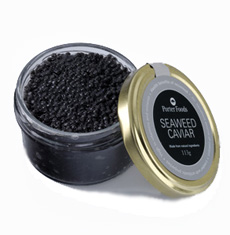
Seaweed caviar. Photo courtesy PorterFoods.co.uk. |
SEVRUGA CAVIAR
The smallest of the Caspian and Black Sea sturgeons (it has also been sighted in the Adriatic, the Danube, and as far as Bratislava), the Sevruga (Acipenser stellatus) can grow to 6.5 feet and 175 pounds, although typically weighs in at about 80. It feeds on plankton. Sevruga is the smallest and also the most common species of sturgeon. It has the most distinctive shape, with a long pointed muzzle in the shape of a scythe. It is less expensive not only because it is more available, but because it reproduces faster that the other species (it begins to bear eggs at 7 or 8 years). Sevruga caviar is the smallest in grain (2 to 2.5mm diameter), and the color is slightly greenish to medium gray to steel gray.
|
Sevruga has the strongest flavor among sturgeon caviars, the crunchiest texture, and traditionally is the least expensive of the three Russian/Iranian caviars. Sevruga has caught up to Osetra in price because of a pull-up effect: the shortage of Beluga created a run on Osetra, making Sevruga more in demand.
|
|
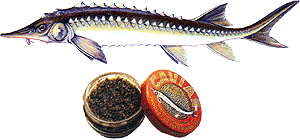
The Sevruga sturgeon and its caviar. Photo courtesy VictoriaPackaging.com. |
However, the 2006 ban on Caspian caviar exports has made Sevruga all but impossible to find except in countries bordering the Caspian, which are permitted to fish the sturgeon. (See note under Beluga about the 2006 ban on export of Russian caviar.) By tradition, Sevruga is sealed by a red-colored lid (yellow is traditional for Osetra and blue for Beluga). Its name comes from the Russian sevryuga. Unlike Beluga (“white”) and Osetr (“sturgeon”), there is no literal translation.
SHAD ROE
Shad roe are the egg sacs of the American shad fish, a member of the herring family. Each female produces a pair of large, lobe-shaped egg sacs. Although the shad fish itself is quite bony and not sought after, its roe is considered a delicacy, rich in flavor and similar, some say, to sweetbreads. The season is brief: anywhere from February to May, depending on location (and water temperature) along the coast). Shad is hard to find on the East Coast, but it remains plentiful on the West Coast through June.
|
|
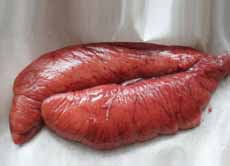
Shad roe. Photo courtesy Inland Seafood. |
SHOVELNOSE STURGEON
An American sturgeon whose roe is marketed as hackleback caviar. The shovelnose is common in the large rivers of Arkansas. This unusual fish has a broad, flat head with four barbels on the underside of the long, space-shaped snout. The body is brown to gray in color and is covered with rows of bony plates. See hackleback caviar.
|
SIBERIAN OSETRA STURGEON
This Osetra sturgeon lives in the cold waters of Siberia, producing a crisp caviar that is only slightly smaller than its Caspian cousin. The roe is brown to jet black in color with a small to medium sized Osetra bead. The flavor is creamy and slightly briny. Due to pollution and other factors, this same sturgeon is farmed in the immaculate waters of Uruguay and also sold under the name Siberian Osetra.
SMELT ROE
See masago.
|
|
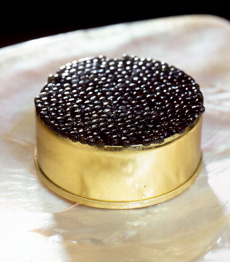
Siberian Osetra caviar. Photo courtesy CaviarRusse.com. |
SMOKED CAVIAR
Some caviar producers smoke whitefish, gravlax, and other roes for added nuance. They can be further seasoned with dill, lemon, and pepper. Collins Caviar of Chicago is one producer of such specialty caviars. On a more affordable level, one of the most popular foods in Sweden is Kalles Caviar, a mild smoked caviar paste in tube that can be squeezed onto bread and crackers for snacks and hors d’oeuvre.
|
|
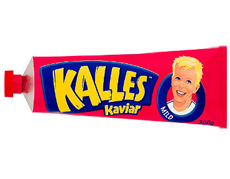
Buy this Swedish specialty online at SwedensBest.com. |
SPHERIFICATION
Spherification is a cooking technique invented by the molecular gastronomy pioneer Ferran Adrià, to create delicious and toothsome “caviar” from fruits and vegetables. It’s the process of taking reshaping a flavorful liquid into into a sphere with a skin on the outside and liquid inside. First, sodium alginate is added to remove air bubbles. Then, the liquid is added to water which has been mixed with calcium chloride. The chemicals react and produce spheres. The process can be used to make sweet or savory “caviars” as ingredients or dish garnishes. If you want to try it at home, here’s how.
|
|
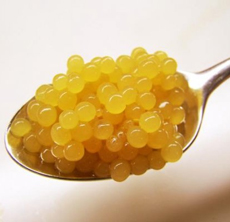
Man made peach “caviar.” Photo courtesy ChickenfriedGourmet.com. |
SPOONBILL STURGEON
See paddlefish sturgeon.
STERLETA STURGEON
Now largely extinct in the Caspian (but farm-raised in the U.S.), the Sterlet sturgeon (Acipenser ruthenus) supplied what was called Imperial Caviar to Iran’s royal family. Writings of year past mention banquets in which the caviar was served—including a caviar soup (which, depending on the recipe, only a royal family could afford). With the sterlet no longer commercially fished due to dwindled stock the, Golden Osetra is now referred to as Imperial Caviar. The Sterlet is similar to, but smaller than, the Sevruga—the large ones are four feet long and weigh 55 pounds. The Sterlet is very rarely found in the wild these days; a small stock is kept by farms for cross-breeding (for example, see Bester and Schipp).
|
|
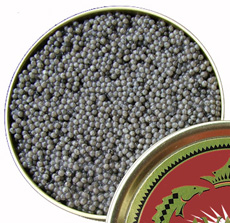
American farm-raised Sterlet caviar. Photo courtesy CaviarStar.com. |
American farm-raised Sterlet caviar is most similar to Caspian Sevruga (Acipenser stellatus), with small grains, dark gray to steel in color and a more pronounced caviar flavor.
STURGEON
A large migratory fish, with about 26 species found worldwide (plus two closely related species of paddlefish); almost all or Endangered or Vulnerable, according to the World Wildlife Foundation. The most famous are the sturgeon of the Caspian Sea and the Black Sea. Other varieties are native to Asia, the Pacific Northwest, Midwest, and South Atlantic regions of North America and the big lakes and rivers in Europe. The sturgeon is an ancient fish that has roamed the cold waters of the northern hemisphere for more than 250 million years—at the same time as the dinosaurs.
Although it is a saltwater fish, the sturgeon spawns each fall and spring in freshwater rivers, and it is there that it is caught for harvesting. The roe is highly prized; after it is salted it is known as caviar. The meat is delicate yet firm and contains virtually no bones. The fillets are rather large, with a taste prized by gourmets. The meat can be prepared in many different ways: It is served both fresh and smoked.
|
|
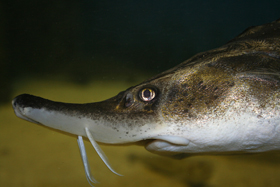
Sturgeon. Photo © Cold fusion |Dreamstime.
|
Sturgeon belong to the family Acipenseridae, an order of primitive ray-finned fishes that includes paddlefish as well as some extinct families. Their subfamily is Acipenser. Within the subfamily there are two geniuses: Acipenser, to which the Osetra, Sevruga, Siberian sturgeon and White sturgeon belong (as well as the majority of the other species); and Huso, which has two members, the Beluga and the Kahlua. There is one other subfamily: Scaphirhynchus, of which the Shovelnose (hackleback) sturgeon, a significant source of caviar, is a member.
STURGEON CAVIAR
The roe of the sturgeon. The caviar is classified according to the sturgeon species and the roe’s size and color. While a few years ago these caviars would have included Beluga, Osetra, Sevruga and pressed caviar, today the American caviar market has grown to include several fine farmed sturgeon caviars, and there is a ban on the export of Caspian caviars. See also White Sturgeon.
SUSTAINABLE CAVIAR
Caviar that is farmed or fished in a responsible manner that does not deplete the resource.
|
|
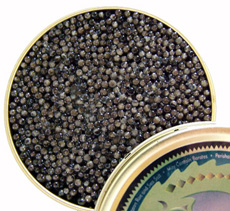
American White Sturgeon caviar. Photo courtesy CaviarStar.com. |
Continue To Next Page: Caviar Terms With T
Go To The Article Index Above
Lifestyle Direct, Inc. All rights reserved. Images are the copyright of their individual owners.

|















